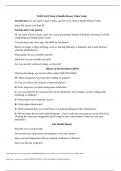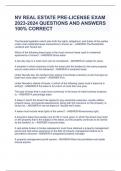DeMarzo - Complete Chapters Included (Chap 1 to 31)
Corporate Finance, 6Ce (Berk)
Chapter 1 The Corporation and Financial Markets
1.1 The Three Types of Firms
1) A sole proprietorship is owned by:
A) one person.
B) two or more people.
C) shareholders.
D) bankers.
Answer: A
Diff: 1 Type: MC
Topic : 1.1 The Three Types of Firms
2) Which of the following organization forms is the most common in the economy?
A) Limited Liability Partnership
B) Limited Partnership
C) Sole Proprietorship
D) Publicly Traded Corporation
Answer: C
Diff: 1 Type: MC
Topic : 1.1 The Three Types of Firms
3) Which of the following organization forms earns the most revenue?
A) Privately Owned Corporation
B) Limited Partnership
C) Publicly Owned Corporation
D) Limited Liability Company
Answer: C
Diff: 1 Type: MC
Topic : 1.1 The Three Types of Firms
4) Which of the following is NOT an advantage of a sole proprietorship?
A) Single taxation
B) Ease of setup
C) Limited liability
D) No separation of ownership and control
Answer: C
Diff: 2 Type: MC
Topic : 1.1 The Three Types of Firms
5) Which of the following statements regarding limited partnerships is true?
A) There is no limit on a limited partner's liability.
B) A limited partner's liability is limited by the amount of his investment.
C) A limited partner is not liable until all of the assets of the general partners have been exhausted.
D) A general partner's liability is limited by the amount of his investment.
Answer: B
Diff: 2 Type: MC
Topic : 1.1 The Three Types of Firms
1
,6) Which of the following are advantages of incorporation?
A) Access to capital markets
B) Limited liability
C) Unlimited life
D) All of the above
Answer: D
Diff: 2 Type: MC
Topic : 1.1 The Three Types of Firms
7) In Canada, a limited liability partnership, LLP, is essentially:
A) a limited partnership without limited partners.
B) a limited partnership without a general partner.
C) just another name for a limited partnership.
D) just another name for a corporation.
Answer: B
Diff: 1 Type: MC
Topic : 1.1 The Three Types of Firms
8) In Canada, which of the following business organization forms cannot avoid double taxation?
A) Limited Partnership
B) Publicly Traded Corporation
C) Privately Owned Corporation
D) Limited Liability Company
Answer: B
Diff: 1 Type: MC
Topic : 1.1 The Three Types of Firms
9) In Canada, the dividend tax credit gives some relief by effectively giving:
A) a lower tax rate on dividend income than on other sources of income.
B) a higher tax rate on dividend income than on other sources of income.
C) the same tax rate on dividend income as on other sources of income.
D) a tax rate of zero on dividend income compared to other sources of income.
Answer: A
Diff: 1 Type: MC
Topic : 1.1 The Three Types of Firms
10) Which of the following statements is most correct?
A) An advantage to incorporation is that it allows for less business regulation.
B) An advantage of a corporation is that it is subject to double taxation.
C) Unlike a partnership, a disadvantage of a corporation is that it has limited liability.
D) Corporations face more regulations when compared to partnerships.
Answer: D
Diff: 2 Type: MC
Topic : 1.1 The Three Types of Firms
2
,11) In Canada, the distinguishing feature of a corporation is that:
A) there is no legal difference between the corporation and its owners.
B) it is a legally defined, artificial being, separate from its owners.
C) it spreads liability for its corporate obligations to all shareholders.
D) it provides limited liability only to small shareholders.
Answer: B
Diff: 2 Type: MC
Topic : 1.1 The Three Types of Firms
12) Which of the following is subject to double taxation in Canada?
A) Corporation
B) Partnership
C) Sole proprietorship
D) Both A and B
Answer: A
Diff: 1 Type: MC
Topic : 1.1 The Three Types of Firms
13) The Canada Revenue Agency, CRA, allows an exemption from double taxation for certain flow-
through entities where all income produced by the business flows to the investors and virtually no
earnings are retained within the business. These entities are called:
A) Canadian Federal Crown Corporations.
B) Canadian Controlled Corporations.
C) Income Trust Corporations.
D) Foreign Controlled Corporations.
Answer: C
Diff: 1 Type: MC
Topic : 1.1 The Three Types of Firms
14) In 2006, the Canadian government effectively neutralized the tax advantages that had existed for most
income trusts, relative to firms set up as corporations. The advantages that existed for income trusts
before these changes were that:
A) income trusts avoided double taxation in that the Canada Revenue Agency did not collect corporate
taxes but rather collected only personal taxes from income trust unit holders.
B) income trusts effectively afforded unlimited liability to unitholders while corporate shareholders could
face unlimited liability.
C) while double taxation existed for both income trusts and corporations, the net tax paid by income trust
unit holders was in most cases less than that paid by corporate shareholders.
D) the changes introduced in 2006 eliminated double taxation for corporations, thereby making the
taxation of income trusts and corporations substantially equivalent.
Answer: A
Explanation: The 2006 changes imposed new taxes on most income trusts to mirror the total tax revenue
received from corporations. As a result, with no material tax advantage, these firms reverted from income
trusts back to a corporate structure. The exception was Real Estate Investment Trusts (REIT), which are
exempted from the changes imposed on all other trusts.
Diff: 2 Type: MC
Topic : 1.1 The Three Types of Firms
3
, 15) One of the major characteristics of a limited liability partnership, LLP, in Canada is:
A) the limitation on a partner's liability is only in cases related to actions of negligence by other partners
or those supervised by other partners.
B) any partner will not be liable for their own negligence at any time.
C) any partners will be only liable for other partners' negligence.
D) none of the above.
Answer: A
Diff: 2 Type: MC
Topic : 1.1 The Three Types of Firms
16) You own 100 shares of a publicly traded Canadian Corporation. The corporation earns $5.00 per share
before taxes. Once the corporation has paid any corporate taxes that are due, it will distribute the rest of
its earnings to its shareholders in the form of a dividend. If the corporate tax rate is 40% and your
personal tax rate on (both dividend and non-dividend) income is 30%, then how much money is left for
you after all taxes have been paid?
A) $210
B) $300
C) $350
D) $500
Answer: A
Explanation: EPS × number of shares × (1 - Corporate Tax Rate) × (1 - Individual Tax Rate)
$5.00 per share × 100 shares × (1 - .40) × (1 - .30) = $210
Diff: 3 Type: MC
Topic : 1.1 The Three Types of Firms
17) You own 100 shares of a Canadian Income Trust Corporation. The corporation earns $5.00 per share
before taxes. Once the corporation has paid any corporate taxes that are due, it will distribute the rest of
its earnings to its shareholders in the form of a dividend. If the corporate tax rate is 40% and your
personal tax rate on (both dividend and non-dividend) income is 30%, then how much money is left for
you after all taxes have been paid?
A) $210
B) $300
C) $350
D) $500
Answer: C
Explanation: EPS × number of shares × (1 - Individual Tax Rate)
$5.00 per share × 100 shares × (1 - .30) = $350
Diff: 3 Type: MC
Topic : 1.1 The Three Types of Firms
4










